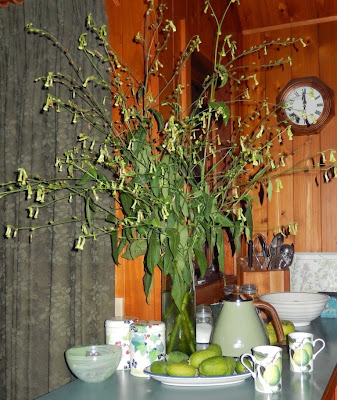Where on earth (ahem) did I read this quote (which I’ve casually popped on
Pinterest), a line I like so much?
Green is my colour and it’s permeated the house – along with wood
(cedar, oregon) and sandstone-like floors – so that I can fancy that I live in
a forest – a very comfortable one. (Big
windows look out to garden, gum trees and sky. (A dell in the dwelling?)) I
love having a vase of flowers, too. So when friends were suddenly invited
around, a week ago, I raided the the rather bare garden for a bunch of blooms.
This pretty tobacco – Nicotiana langsdorffii
– has soft lime green flowers, not large, but the sheer size of the bouquet
(the whole plant) rendered the installation a rather too-large infiltration
into our living room-kitchen. Or did it? The soft colour of the flowers recede
and after a day or two I took pity on J and trimmed off some stems so that
making coffee was once again possible... and yes, the leaves here have drooped
after a whole week in a vase (and seeds started to drop all over). UK
perennial-grower Sarah Raven describes this chartreuse flower wonderfully as a
“puffy Shakespearean purse flowered tobacco” but I’m surprised to see how long
these flowers have lasted and I love to rest my eyes on the various green
shades and hues: flowers and leaves, along with apples from the garden, and feijoas
from friends.

Nicotianas come in pink and white,
tall and short, too, some perfumed; with a lovely range of seed available from
Chiltern Seeds. Deep pink-almost burgundy-edged Nicotiana
(an annual) would look well in my garden bed du jour, my passion, the silver and raspberry bed. Just beware the
hundreds of seeds these tobaccos produce.
Tesselaar’s catalogue was tossed into our letter box last week and Lilium, in particular, catch the eye –
for this part of the garden. Raspberry and cherry ones look too big and bold
somehow but lilies of strawberry-colour and of my mothers handmade strawberry
icecream, well, they are just irresistible. The size of the blooms will surely
give them chutzpah and (hopefully) forgive any perceived insipidity against the
silver foliage; this requires careful thought – and even more careful
placement. (So now this garden bed has flowers in the colours of plum,
raspberry, cherry and strawberry...and even blood plum: black tulips. Delicious!
As well as balls of green; structural spheres have at last been planted here...thank
you to my generous nephew for these plants.)
It’s not as if the silver and...ruby garden bed is wall to wall silver;
there’s also blue-grey leaves of Aquilegia
and grey leaves of pink California
poppies; green leaves of Agastache and
peony, silver-grey leaves of miniature lamb’s ears and darker grey leaves of the
handsome large leaf form. Pelargonium sidioides (left) magically has flowers of ruby-plum over
leaves of silver-grey.
Silver shimmers and sparkles; there’s only 2 areas of large (1m high)
subshrubs of silver in this jewel bed, which advance to the eye, as does the
strongest of the pinks here, while the other colours , particularly grey,
retreat. There’s also white: plume poppy (Macleaya
cordata) which when ruffled in the wind, tosses its grey-green leaves so
the white underneath is strongly contrasted.
Grey foliage is a great foil: set a flower against it for maximum impact. But
some people find grey foliage dull and I am one of them, so there’s not too
much grey here and none elsewhere in the garden. Grey can provide the eye with
rest after a strong colour but I’d rather use green - used between areas as an intermezzo if you will.
(Roger Spencer writes in `Growing Silver, Grey and Blue Foliage Plants’
(1987) that we might plant grey foliage plants in our gardens as reminders of “pleasant
holidays” by “salt air”,...“white scrub in the interior or the silvery
herbfields of our alps.” My most major criterion for my garden is not a reminder
of holidays, domestic or abroad, but beauty.)
But green is the most important colour in the garden (just look at hectic
gardens that are wall to wall flowers; they are set to induce seizures or
severe nausea at least) and the green in my silver bed will set off the pink
lillies well. (Too much silver would look un-natural and jarring; there is plentiful
green in my silver bed.)
Think of green colours: sea green, forest green, moss green, eucalypt
green, sage green, grass green; they refresh the soul, they are needed in our
lives.
Green is the colour of life, nature and growth, and said to be the colour
of harmony and fertility. It’s the colour of spring, of renewal, of rebirth.
Green “renews and restores depleted energy” I read; but it’s restful, too.
So as I hack back my perennials I plan a few more evergreens for winter
greenery but plan for lots of green year-round too. I might even water my
little circle of lawn a bit (we have tanks) in summer.
Jill Weatherhead is horticulturist, writer, garden
designer and principal at Jill Weatherhead Garden Design who lives in
the Dandenong Ranges east of Melbourne, and works throughout Victoria (www.jillweatherheadgardendesign.com.au)













